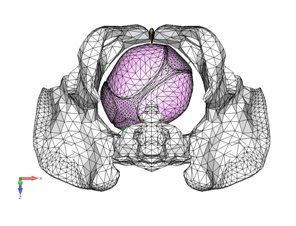Imaging Software Simulates Childbirth
CHICAGO - Great strides have been made in the past century in ensuring women's safety during childbirth. Now, new imaging software presented Tuesday at RSNA furthers this by simulating childbirth to predict difficult deliveries.
CHICAGO - Great strides have been made in the past century in ensuring women's safety during childbirth. Now, new imaging software presented Tuesday at RSNA furthers this by simulating childbirth to predict difficult deliveries.
Because of the upright position of humans and the large head size of a fetus, the movement of a fetus through the birth canal of a woman is more complicated than that of other animals, leading to a higher risk of dystocia, or difficult labor. Olivier Ami, MD, of Antoine Béclères Hospital at Université Paris Sud, France, and colleagues used software called Predibirth in conjunction with MR images to study 24 pregnant women and their delivery outcomes.
They produced 3-D reconstructions of the fetus and each woman's pelvic measurements, with which they simulated 72 possible trajectories of the fetal head through the birth canal. Animation of the fetus was obtained by the adjunction of a skeleton to the 3-D reconstruction of the fetus.
“The computer simulates what we call collision detection,” Ami said. The software tries to find a trajectory of the given fetal head through the pelvis, and a collision is detected if it is not possible. Based on these results, each mother was scored on her likelihood to have a favorable childbirth.
In a highly favorable birth, there is no potential collision detected. In a mildly favorable birth, there is less than 3 percent of fetal head volume reduction, as the head may be slightly molded during childbirth. If the fetal head volume reduction is over 3 percent, there is an unfavorable birth, which corresponds to potential brain damage or inability to deliver vaginally.
The Predibirth scores in the study were computed retrospectively and compared with actual delivery outcomes. Of the 24 pregnant women, the 13 who delivered vaginally were all scored as highly favorable by the simulator. Three women who had elective cesarean sections (C-section) also had scores for high dystocia risk.
Emergency C-section for obstructed labor occurred in three patients, who were estimated to have high risk for dystocia. Three instrumental extractions, meaning use of a vacuum to aid in delivery, were scored as mildly favorable.

“We could've targeted the emergency C-section for obstructed labor, and the instrumental extractions, for planned Cesarean sections,” Ami said.
The imaging tests were performed during the last month of pregnancy. “The more you are performing it close to the delivery, the more it is accurate,” Ami said. Extrapolation curves for the growth of the head are also available when a test is performed earlier in the pregnancy.
Approximately a third of all births in the U.S. are delivered through C-sections. An emergency C-section has significantly higher risk for mortality as compared to a planned C-section.
Can MRI-Based AI Bolster Biopsy Decision-Making in PI-RADS 3 Cases?
December 9th 2024In patients with PI-RADS 3 lesion assessments, the combination of AI and prostate-specific antigen density (PSAD) level achieved a 78 percent sensitivity and 93 percent negative predictive value for clinically significant prostate cancer (csPCa), according to research presented at the Radiological Society of North American (RSNA) conference.
The Reading Room: Artificial Intelligence: What RSNA 2020 Offered, and What 2021 Could Bring
December 5th 2020Nina Kottler, M.D., chief medical officer of AI at Radiology Partners, discusses, during RSNA 2020, what new developments the annual meeting provided about these technologies, sessions to access, and what to expect in the coming year.
RSNA 2020: Addressing Healthcare Disparities and Access to Care
December 4th 2020Rich Heller, M.D., with Radiology Partners, and Lucy Spalluto, M.D., with Vanderbilt University School of Medicine, discuss the highlights of their RSNA 2020 session on health disparities, focusing on the underlying factors and challenges radiologists face to providing greater access to care.
New Interventional Radiology Research Shows Merits of Genicular Artery Embolization for Knee OA
December 3rd 2024In a cohort of over 160 patients with knee osteoarthritis (OA), including grade 4 in nearly half of the cases, genicular artery embolization led to an 87 percent improvement in the quality of life index, according to research presented at the recent RSNA conference.
Siemens Healthineers Debuts New Photon-Counting CT Systems at RSNA
December 2nd 2024Debuting at the Radiological Society of North American (RSNA) conference, the new photon-counting computed tomography (PPCT) scanners Naeotom Alpha.Pro and Naeotom Alpha.Prime reportedly combine rapid scan times with high-resolution precision.